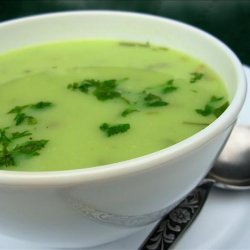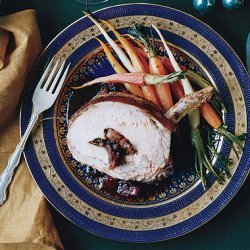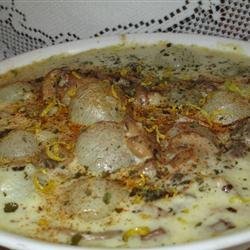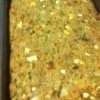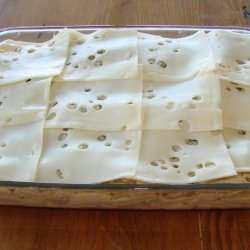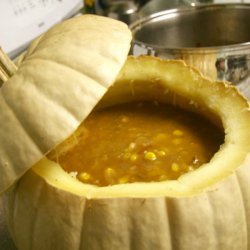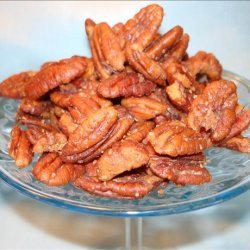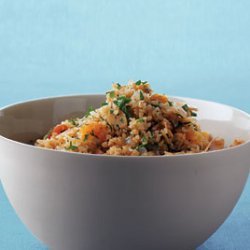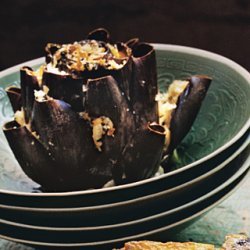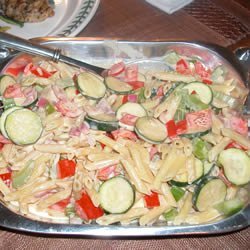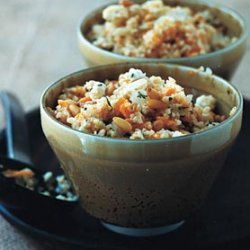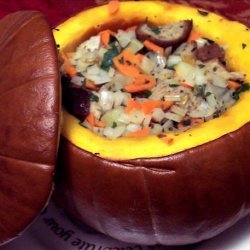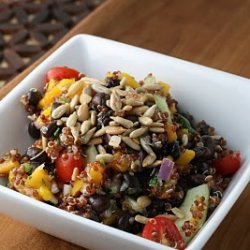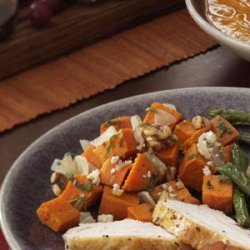Ingredients:
- 1 loaf good-quality commercially made presliced whole wheat bread
- 1 to 2 stalks leafy celery, diced (leaves included)
- vegetable stock (see tip, below ) as needed
- tamari or shoyu soy sauce to taste
- a small amount of dried leaf basil and oregano to taste (optional)
- salt and freshly ground black pepper to taste
- cooking spray (optional)
Directions:
- Pumpkin prep: Cut off and reserve a lid, as you would preparatory to carving a jack-o'-lantern. Scoop out all of the seeds and fibers. Put an inch or two of water in a large pot. Place the pumpkin, cut side down, in the water, cap wedged in near it. Bring to a boil over high heat. Cover tightly and team for 10 to 15 minutes to precook slightly. Remove the pot from the heat and let cool. When cool, remove from the pot. Since the pumpkin will be eaten with the stuffing, I like to season the inside with salt, pepper, a little tamari, Pickapeppa, and brown sugar, rubbing this into the exposed interior flesh after steaming.
- 1. Place the apricots and prunes in a small, heatproof bowl. Place the apple juice in a small saucepan over high heat and bring to a boil. Immediately pour the juice over the dried fruit. Let stand for at least 2 hours, but overnight or a day or two in advance is fine. Drain the dried fruit, reserving both the fruit and the soaking liquid. Coarsely chop the fruit and set aside.
- 2. Preheat the oven to 375°F, then turn down to 200°F.
- 3. Set a wire rack on a baking sheet and place a single layer of bread slices on the rack. Place in the preheated oven and bake, slowly, turning once, until the bread is hard, crunchy, and dry all the way through, but not browned. This is a fairly slow process it might take 45 to 60 minutes, but set the timer at 20-minute intervals to remind you to check. You with either need to do 2 sheets' worth of bread (in which case, reverse their positions in the oven halfway through), or repeat the toasting process again until all bread is prepared. Remove the dry bread from the oven and let cool.
- 4. Coarsely crumble the bread into a large bowl. Add the onion and leafy celery and toss to combine. Measure the sage (starting with the smaller amount) into your hands and rub the leaves back and forth in your palms until they crumble (this releases the volatile essential oils). Add the sage to the bread mixture. Pour the melted butter over the mixture and toss well to combine. Add the soaked dried fruit and toss again. The dressing should still be dry. Begin adding the liquid, a combination of vegetable stock and the reserved fruit soaking liquid. Use more stock than juice, and use just enough to moisten the dressing without making it soggy. Keep tossing, adding stock as needed. Add tamari, starting with about 1 tablespoon. Taste for salt and add it and plenty of pepper to taste. More sage, maybe? This is also the point at which you can add a little dried basil and oregano, too, if you like. The stuffing can be prepared up to this point and stored, covered and refrigerated, overnight.
- 5. On the day you plan to stuff the pumpkin, preheat the oven to 375°F.
- 6. If not using nonstick, spray a baking dish large enough to accommodate the pumpkin with cooking spray.
- 7. Stuff the dressing into the cavity of the prepared pumpkin, topping with the pumpkin's cap. Place the stuffed pumpkin in the prepared baking dish. Place in the preheated oven and bake until the pumpkin is slightly brown and looks a bit collapsed in on itself, or, as Ned says, like a plump European duchess, about 40 minutes. Serve whole, at the table.
- Crescent Dragonwagon shares her tips with Epicurious: If you don't have time to make your own vegetable stock, Dragonwagon recommends the dark vegetable stock by Kitchen Basics. Packaged or homemade, these stocks are certainly healthier than meat stocks, but as Dragonwagon notes in Passionate Vegetarian, a high-quality vegetable stock does not sacrifice flavor: It is good stock that underpins the glossy, piquant, sweet, or hot sauces that transform tofu, tempeh, and seitan from plain basics to genuinely satisfying dishes that speak cogently of abundance, not deprivation or blandness for the sake of health.
Nutrition Facts
| Amount Per 1 Serving | |||
| Calories | 1345.35 Kcal (5633 kJ) | ||
| Calories from fat | 426.64 Kcal | ||
| % Daily Value* | |||
| Total Fat | 47.4g | 73% | |
|---|---|---|---|
| Cholesterol | 122.01mg | 41% | |
| Sodium | 39.92mg | 2% | |
| Potassium | 3673.02mg | 78% | |
| Total Carbs | 242.8g | 81% | |
| Sugars | 169.32g | 677% | |
| Dietary Fiber | 25.86g | 103% | |
| Protein | 10.72g | 21% | |
| Vitamin C | 121mg | 202% | |
| Vitamin A | 0.6mg | 19% | |
| Iron | 7.1mg | 39% | |
| Calcium | 256mg | 26% | |
* Percent Daily Values are based on a 2000 calorie diet. Your daily values may be higher or lower depending on your calorie needs.
Find out how many calories should you eat.
Get Your Recipe of Health!
Follow RecipeOfHealth on Facebook!


